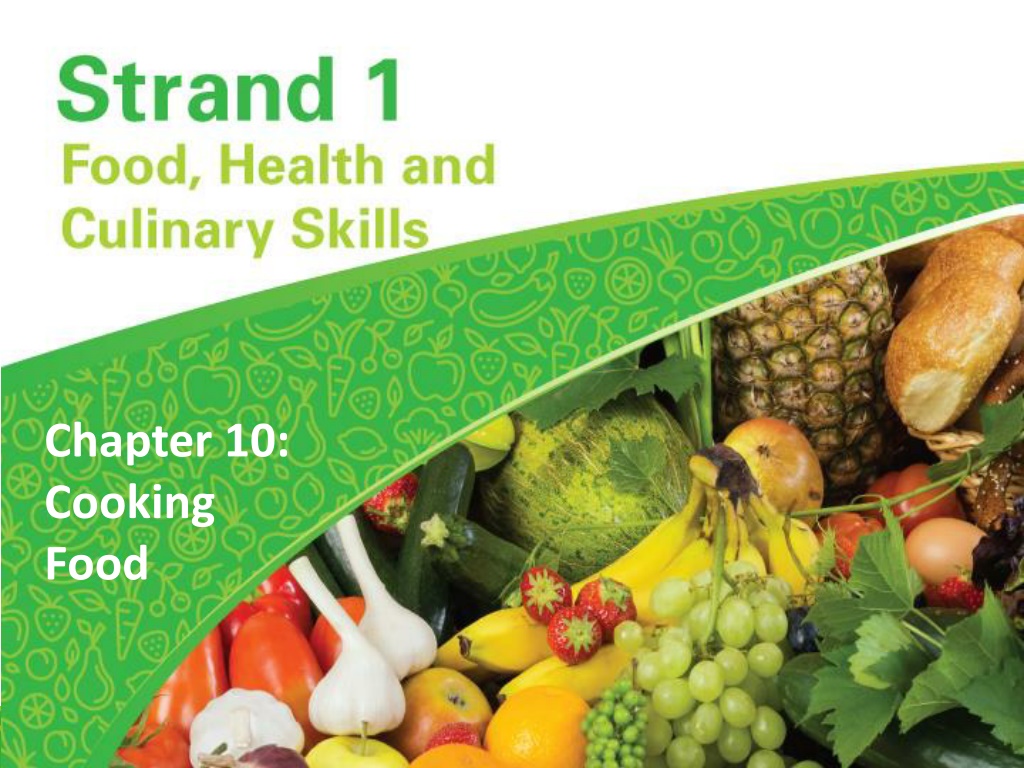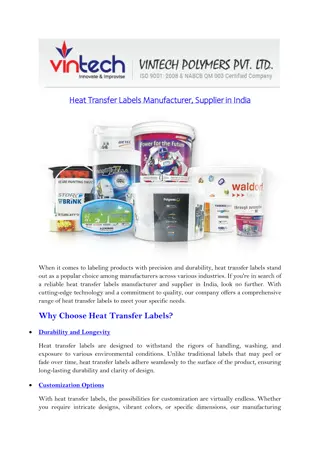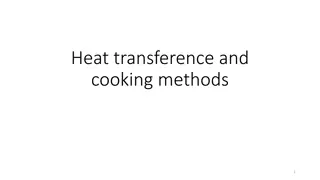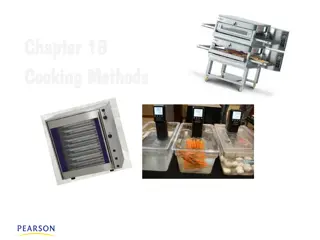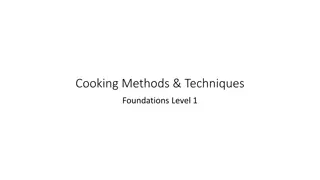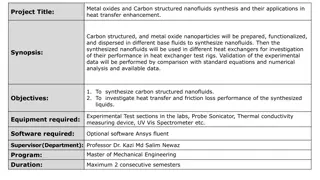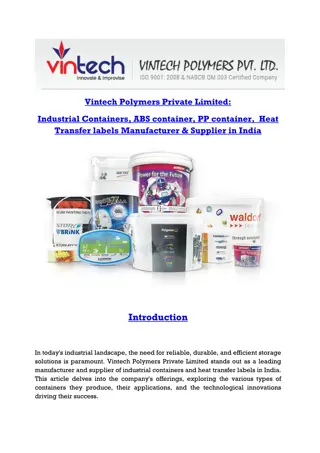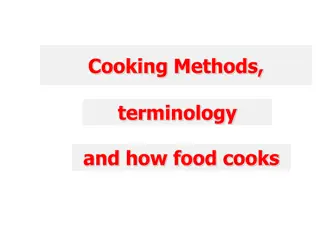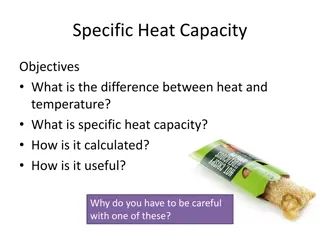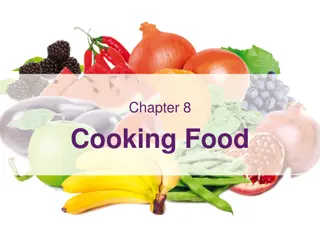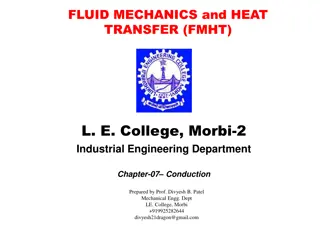Understanding the Science of Cooking: Heat Transfer, Changes, and Methods
Explore the reasons for cooking food, the changes that occur when food is cooked, the importance of heat transfer in cooking methods, and the risks of overcooking. Learn about different heat transfer methods like conduction, convection, and radiation, and how they impact the texture, flavor, and safety of food. Discover the various effects of cooking on bacteria, proteins, color, texture, and nutrients in food.
Download Presentation

Please find below an Image/Link to download the presentation.
The content on the website is provided AS IS for your information and personal use only. It may not be sold, licensed, or shared on other websites without obtaining consent from the author. Download presentation by click this link. If you encounter any issues during the download, it is possible that the publisher has removed the file from their server.
E N D
Presentation Transcript
Chapter 10: Cooking Food
What I Will Learn To explain why food is cooked To identify the changes that occur when food is cooked To outline three methods of heat transfer To describe: moist cooking methods dry cooking methods methods that use fat
Reasons for Cooking Food Some foods, like fruits and vegetables, can be eaten raw. However, we usually cook food for the following reasons: To kill bacteria, making food safer to eat To preserve food so it lasts longer, e.g. cooked chicken lasts longer than raw chicken To make food easier to eat and digest, e.g. starchy foods like potatoes and rice soften To improve appearance and flavour of food To stimulate digestive juices through sight and smell To add variety to our diets by combining ingredients and create new flavours, e.g. curries
Changes That Occur When Food is Cooked All cooking requires heat, which has the following effects on food: Bacteria are destroyed. Protein coagulates (hardens), e.g. the white of an egg. Colour changes, e.g. meat changes from red to brown or from pink to white. Foods soften, making them easier to digest, e.g. potatoes and apples.
Changes That Occur When Food is Cooked (continued) Water evaporates and food shrinks in size, e.g. meat and fish. Flavours and aromas are developed, e.g. meat extractives released from meat fibres improve the taste and smell. Fat melts. Starch grains swell, burst and absorb liquid, e.g. rice, pasta and sauces. Some vitamins and minerals are lost.
Overcooking Be careful not to overcook food, as it causes: Loss of colour, flavour and texture Some foods to become tough and indigestible Further loss of vitamins and minerals Fuel wastage
Heat Transfer All cooking methods involve heat. The heat must be transferred from the heat source to the food. This can be done by: Conduction Convection Radiation
Heat Transfer: Conduction Conduction is: Examples: Frying Boiling Simmering Stewing Barbequing The transfer of heat from one molecule to another by vibration. The food being heated must be in direct contact with the heat source, e.g. heat passing from the cooker hob through the base of the saucepan into the food.
Heat Transfer: Convection Convection is: Examples: Simmering Baking Roasting When the molecules near a heat source become hot, less dense and rise up. Cold molecules take their place. This sets up convection currents and heat is spread through liquids and gases. This movement of hot and cold gas/liquid creates an even temperature in the oven or saucepan.
Heat Transfer: Radiation Radiation is: Heat passes in straight rays, from the source, to the first solid object they reach, without heating air in between. The food needs to be as close as possible to the heat rays. Examples: Grilling burgers Making toast Microwaving
Choosing Cooking Methods Consider: The ingredients, e.g. stewing would be a better cooking method for cheaper cuts than frying (Why?) The experience of the cook, e.g. boiling might be easier than using a pressure cooker The cost of fuel, e.g. uneconomical to cook small amounts in a large oven The time available to prepare and cook the meal The equipment available The result you want, e.g. soft, crisp, moist or low-fat Retention of nutrients Personal tastes, e.g. raw, rare, medium or well-done
Moist Cooking Methods: Boiling/Simmering Definition: Cooking by convection and conduction in liquid at 100 C (boiling) or 90 C (simmering) in a covered saucepan on the hob. Guidelines: 100 C or 90 C (bubbling) at all times. Use a small amount of liquid for vegetables. Use cooking liquid as base for soups or sauces. Cook food for the shortest possible time. Suitable foods: Meat Eggs Pasta and rice Vegetables
Moist Cooking Methods: Boiling and Simmering (continued) Advantages Needs little attention Clean Food stays moist and juicy Digestible Less greasy Little preparation Nourishing method Disadvantages x Little flavour added x Loss of nutrients x Lacks texture x Risk of overcooking
Moist Cooking Methods: Poaching Definition: Cooking by convection and conduction in liquid at 85 C in a covered container on the hob or in the oven. Suitable foods: Fish De-shelled eggs Fruit, e.g. pears Guidelines: 85 C at all times Water barely moving, not bubbling Use for delicate foods that need gentle cooking
Moist Cooking Methods: Poaching (continued) Advantages Clean Food stays moist and juicy Digestible Not greasy Disadvantages x Needs attention x Little flavour added x Loss of nutrients x Lacks texture x Slow
Moist Cooking Methods: Steaming Definition: Food can be steamed: Cooking food slowly in steam rising from boiling water. In a covered bowl in a saucepan of boiling water Over a pan of boiling water On a trivet or separator basket in a pressure cooker In a steamer over boiling water
Moist Cooking Methods: Steaming (continued) Guidelines: A tightly fitting lid prevents evaporation Water boiling before and during cooking Food must not touch liquid Suitable foods: Thin pieces of chicken and fish Steamed puddings, e.g. jam roly poly, Christmas or chocolate pudding Vegetables, e.g. potatoes, spinach
Moist Cooking Methods: Steaming (continued) Advantages Clean Food stays moist and juicy Digestible Not greasy No loss of nutrients Disadvantages x Little flavour added x Lacks texture x Slow x Not suitable for large pieces of food
Moist Cooking Methods: Stewing/Casseroling Definition: Slowly cooking food in a little liquid by conduction and convection, using gentle heat (80 90 C) in a covered container on the hob or in the oven. Suitable foods: Tough cuts of meat/fish Vegetables, e.g. potatoes, carrots Fruit, e.g. apples and rhubarb Guidelines: Bring to the boil and reduce heat to a constant 80 90 C to prevent meat becoming tough and fish or vegetables falling apart. Keep covered to prevent evaporation. Use a pressure cooker to reduce time.
Moist Cooking Methods: Stewing/Casseroling (continued) Advantages Disadvantages Little attention needed Food stays moist Complete meal in one pot saves fuel and washing-up Less nutrient loss Digestible Clean Not very greasy Suitable for large numbers x A lot of preparation x Slow x Lacks texture x A lot of flavour needs to be added
Moist Cooking Methods: Braising Definition: Cooking meat in a small amount of stock, on a layer of vegetables (mirepoix). Meat is in a covered saucepan on the hob. Combination of steaming and stewing. Suitable cuts: Root vegetables Chicken Offal Tougher cuts of meat Guidelines: Use for delicate foods that need gentle cooking. Use only enough stock to cover vegetables. Food can be browned under grill before serving.
Moist Cooking Methods: Braising (continued) Advantages Little attention needed Food stays moist Complete meal in one pot saves fuel and washing up Less nutrient loss Digestible Disadvantages x A lot of preparation x Slow x Lacks texture
Dry Cooking Methods: Baking Guidelines: Pre-heat oven. Steam made in the oven stops food drying. Tin foil and greaseproof paper should also be used. Avoid opening the oven door. Definition: Dry method of cooking food by convection currents in the oven. Suitable foods: Bread, cakes, biscuits, pastries Vegetables, e.g. potatoes, peppers Fruit and fruit puddings, e.g. apple crumble
Dry Cooking Methods: Baking (continued) Advantages Attractive appearance Doesn t add fat Little loss of nutrients Adds lots of flavour A number of items can be cooked at same time, saving time and energy Disadvantages x A lot of preparation x Dries food x Slow
Dry Cooking Methods: Baking (continued) Top Tips Always preheat the oven fully. Bake in large batches to make full use of the oven and to save on fuel. Adjust the shelves before the oven heats up. Do not open the oven door, especially at the start of cooking, as the buns or cakes will collapse.
Dry Cooking Methods: Grilling/Barbequing Guidelines: Pre-heat grill or barbeque. Seal surface of food with high heat to prevent nutrient loss. Use tongs to turn food. Cook thin pieces of food only. Don t salt food before grilling. Oil grill grid to prevent sticking. Grilling: Fast method of cooking food by radiant heat under a grill. Barbequing: Cooking food by radiant heat on a grid over glowing charcoal.
Dry Cooking Methods: Grilling/Barbequing (continued) Advantages Fast Little loss of nutrients Reduces fat content Attractive appearance and taste Disadvantages x Constant attention needed x Dries food x Spatters grease x Unsuitable for tough or thick cuts of meat Suitable foods: Meat, e.g. chops, steaks, burgers, rashers. Vegetables, e.g. peppers, Fish
Dry Cooking Methods: Roasting/Pot Roasting Definition: Cooking food in a little fat in: a roasting tin in the oven a saucepan on the hob (pot roasting) on a spit, under a grill or in an oven (spit roasting) Suitable foods: Meat beef, lamb, pork Poultry Vegetables, e.g. potatoes, carrots, beetroot and parsnip
Dry Cooking Methods: Roasting/Pot Roasting (continued) Guidelines: Pre-arrange the shelves and pre-heat the oven. Cooking time depends on weight. Baste every 30 minutes. Use cooking juices for gravy. Time carefully. Quick roasting (for tender cuts) 220 C /gas 7 for 20 minutes then 190 C/gas 5 for remainder. Slow roasting (for less tender cuts) 180 C/gas 4 for all the cooking time.
Dry Cooking Methods: Roasting/Pot Roasting (continued) Disadvantages Advantages Vegetables and meat can be cooked together. Cooking liquid can be used as gravy. Attractive appearance and taste. Not much preparation required. x Spatters grease x Unsuitable for tough or thick cuts of meat x Greasy x Shrinkage occurs x Adds fat
Frying Definitions: Dry frying is cooking fatty foods by conduction in a frying pan on the hob. Stir frying means tossing food in hot fat in a wok, e.g. strips of chicken and vegetables. Shallow frying is cooking food in hot fat, e.g. pancakes. Deep frying is cooking food immersed in hot fat, which is often coated, e.g. fish.
Frying (continued) Guidelines: Pre-heat oil or wok before oil is added. Use tongs for turning regularly. Drain before serving. Suitable foods: Meats thin pieces, e.g. rashers, chops, burgers, sausages Fish thin pieces, e.g. steaks, cutlets, fillets Eggs Vegetables and fruits, e.g. chips and onions, pineapples and bananas
Frying (continued) Advantages Quick Attractive taste and appearance Disadvantages x Constant attention needed x Spatters grease x Unsuitable for tough or thick cuts of meat x Not suitable when cooking for large numbers x Greasy x Indigestible
Frying (continued) Why do we coat foods for frying? It protects the surface of the food while the inside is cooking. It prevents foods from becoming soggy or greasy by absorbing too much fat. It prevents foods from breaking up during cooking. It improves the appearance and texture of food, e.g. golden colour and crispy coating. It improves the nutritive value and flavour, e.g. egg and breadcrumbs. It prevents strong flavours of some foods getting into the fat.
Frying (continued) Frying pan safety Never overheat the oil because if overheated, it will reach: Smoke point: A blue haze rises from the fat Flash point: The fat ignites (burst into flames) Never leave the frying pan unattended. Never move the frying pan while the oil is hot. If the pan catches fire, place a damp cloth or ideally a fire blanket over the flames. (Why?) Do not unplug an electric deep fat fryer place the lid or a fire blanket over the flames. Do not try to move the pan off the heat or throw water onto the fat. (Why?)
Microwave Cooking Definition: Microwave cooking is a very fast method of cooking by conduction in a microwave oven. Electro-magnetic waves penetrate the food to a certain depth and cause the molecules to vibrate very rapidly, causing intense heat. The remainder of the food cooks by conduction. Suitable for: Defrosting, e.g. meat, bread, cakes Reheating, e.g. curry, lasagne Cooking food,e.g. scrambled eggs Melting chocolate Heating liquids
Microwave Cooking (continued) Guidelines for microwave cooking Time food accurately and follow the manufacturer s instructions carefully. Timing is affected by: Composition,e.g. foods containing fat or sugar cook quickly. Thickness, e.g. small, thin pieces of food cook quicker than larger, thick pieces. Density, e.g. light, open foods like bread and cakes cook faster than dense foods like potatoes. Temperature at the beginning,e.g. the cooler the food, the longer it takes to cook. Amount larger quantities take longer to cook.
Microwave Cooking (continued) Guidelines for microwaving Cover food to prevent splatters and retain steam to keep it moist and cook it faster. Turn or stir regularly to ensure even cooking. Arrange food in a circle with the thickest piece facing outwards. Pierce skins, e.g. potatoes, tomatoes and sausages to prevent bursting. Only use suitable containers do not use metal or foil as it can damage the magnetron. Allow standing time as the food continues to cook until it begins to cool.
Microwave Cooking (continued) Advantages Reduces cooking time and saves energy Relatively inexpensive to buy Reduces wash up Good retention of colour, flavour and texture Easy to clean and maintain Good for defrosting food quickly Disadvantages x Unsuitable for cooking some foods x Food overcooks easily x Requires suitable cookware
Activity: Cooking Work Sheet Complete the revision sheet on page 128 of the Zest for Life textbook.
